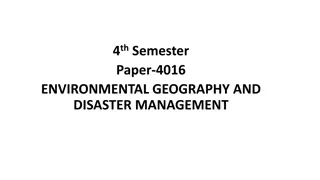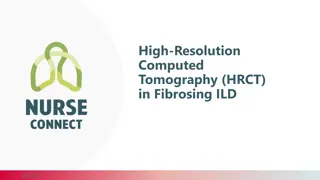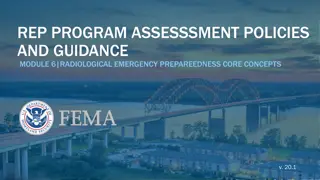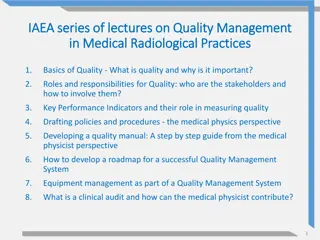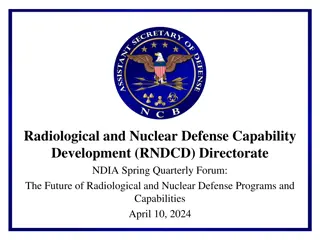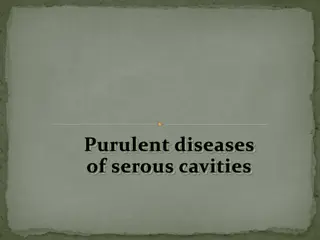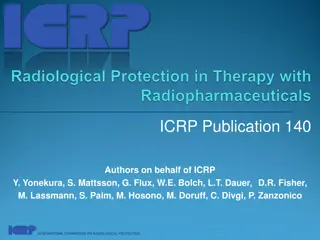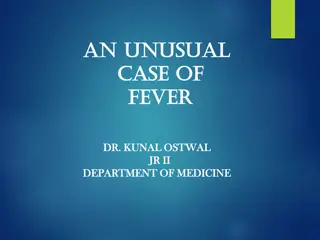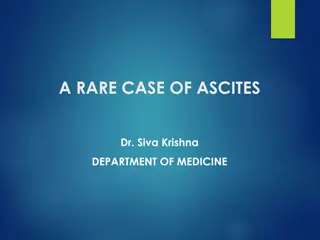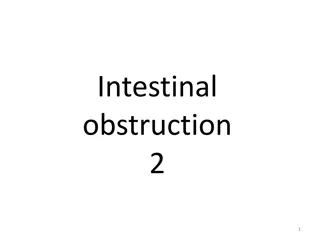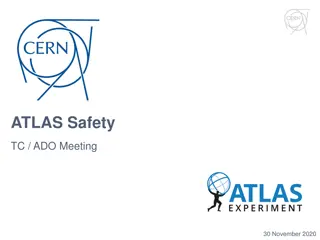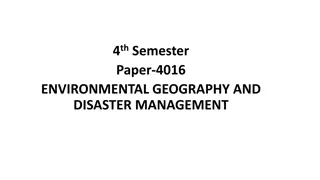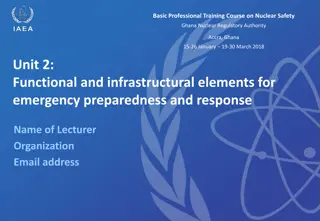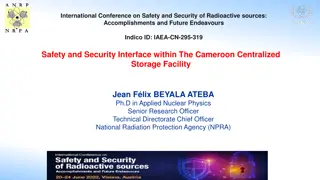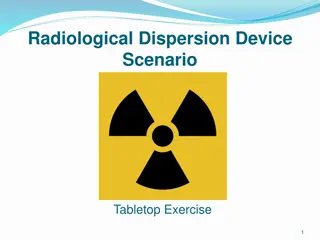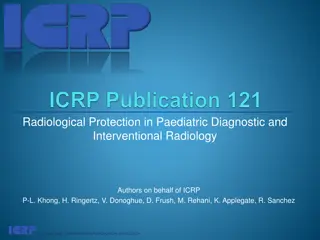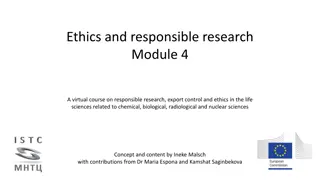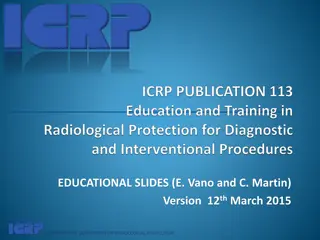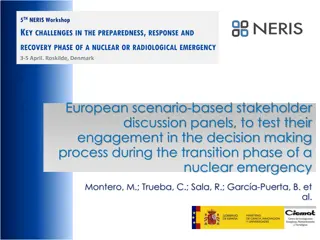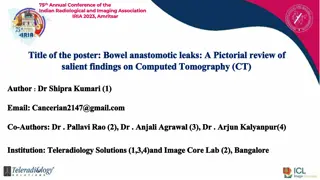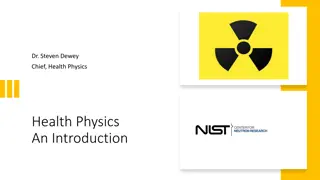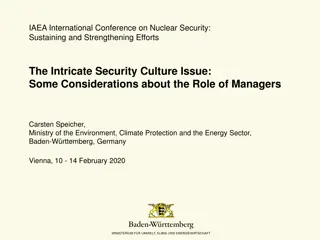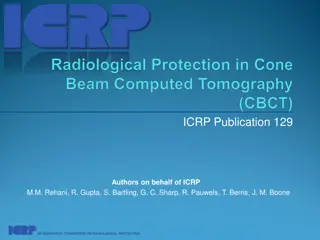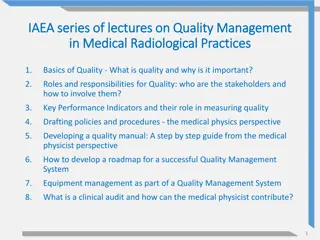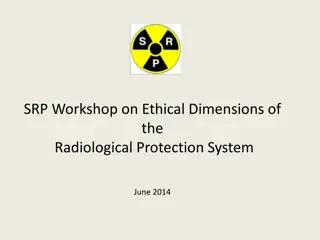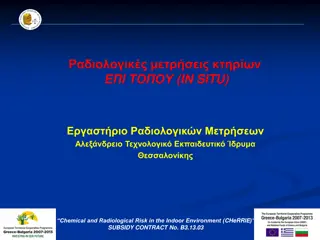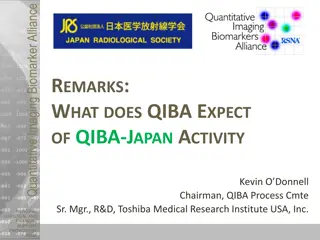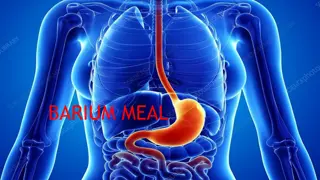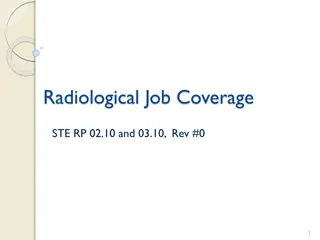Chest Imaging Interpretation for Tuberculosis Screening
Chest imaging plays a crucial role in screening for pulmonary tuberculosis (TB). This activity, led by Dana Kissner from Wayne State University Detroit Tuberculosis Clinic, focuses on interpreting chest imaging results to aid in the diagnosis and management of TB cases. The content includes informat
3 views • 22 slides
Nuclear Emergencies and Disaster Management in India
This article discusses the growth of nuclear technology in India and the risks associated with nuclear and radiological emergencies. It covers the types of nuclear emergencies, emergency response plans, and the institutional mechanisms in place to handle such situations effectively.
2 views • 10 slides
Role of High-Resolution Computed Tomography in Fibrosing Interstitial Lung Diseases
HRCT plays a crucial role in diagnosing and monitoring fibrosing interstitial lung diseases (ILDs). It helps identify abnormalities not visible on X-rays, leading to early, accurate diagnoses and potentially avoiding invasive procedures. HRCT assists in distinguishing specific ILDs based on radiogra
1 views • 25 slides
Radiological Investigation of Hepatobiliary System and Imaging Modalities Overview
Exploring the hepatobiliary system through radiology, this lecture covers the anatomy, modalities like X-ray, Ultrasound, CT scan, MRI, and nuclear scan used for imaging, their advantages, disadvantages, and indications. It delves into the significance of liver, gallbladder, and biliary duct imaging
2 views • 37 slides
Radiological Emergency Preparedness Program Assessment Guidance
This module covers the assessment policies and guidance for radiological emergency preparedness programs. It includes key concepts such as metrics for program evaluation, FEMA's assurance determination process, specific demonstration requirements, capability targets, and critical tasks. Participants
4 views • 22 slides
IAEA series of lectures on Quality Management in Medical Radiological Practices
Quality management in medical radiological practices is crucial for ensuring the delivery of high-quality healthcare services. This series of lectures covers topics such as the basics of quality, roles and responsibilities, key performance indicators, drafting policies, developing a quality manual,
4 views • 54 slides
Comprehensive Insights into Quality Management in Medical Radiological Practices
Explore a series of lectures by the IAEA focusing on quality management in medical radiological practices, covering essential topics such as the basics of quality, key performance indicators, drafting policies, equipment management, and more. Gain a thorough understanding of KPIs, their significance
0 views • 48 slides
Future of Radiological and Nuclear Defense Programs and Capabilities
The Radiological and Nuclear Defense Capability Development Directorate discusses the responsibility for modernizing and procuring defense capabilities in the face of radiological and nuclear threats. The Department of Defense outlines strategic priorities to ensure the ability to survive and prevai
1 views • 10 slides
Purulent Diseases of Serous Cavities: Understanding Purulent Pleurisy and Empyema Pleurae
Purulent diseases of serous cavities, specifically purulent pleurisy and empyema pleurae, are marked by the secondary nature of inflammation in the parietal and visceral pleura. The classification details the etiology and clinical variations, while the pathogenesis explains the development from vari
0 views • 31 slides
Quantitative Imaging and Dosimetry for Radiopharmaceutical Therapy Planning
This presentation highlights the importance of quantitative imaging and dosimetry in planning radiopharmaceutical therapy. It emphasizes the need for individualized dosimetry to tailor treatment procedures and verify the absorbed dose delivered. The content discusses the framework provided for treat
0 views • 34 slides
Unusual Case of Fever with Gastrointestinal Symptoms in a 22-Year-Old Patient
A 22-year-old male from Pune presents with high-grade fever, chills, myalgia, arthralgia, loose stools, and vomiting for 2 days. Past history is unremarkable, while the family history includes hypothyroidism in the mother and hypertension in the father. General examination reveals normal vital signs
0 views • 22 slides
A Rare Case of Ascites in a 22-Year-Old Female: Clinical Presentation and Investigations
A 22-year-old female presented with abdominal distension and pain. Her medical history, family history, and personal habits were reviewed. Examination revealed mild hepatomegaly and shifting dullness. Lab investigations showed normal values with no signs of infection. Ascitic fluid analysis indicate
1 views • 20 slides
Understanding Different Types of Radiation Emergencies
Explore the various types of radiation emergencies such as those from nuclear facilities, medical sources, illicit trafficking, and malicious acts. Learn about threat categories, nuclear emergencies, and radiological emergencies to better understand safety protocols and potential risks associated wi
0 views • 15 slides
National Free Diagnostics Initiative Overview
The National Free Diagnostics Initiative aims to provide essential diagnostic services free of cost in public health facilities, leveraging existing institutional structures. The initiative covers a range of pathological and radiological tests at different levels of care, with outsourcing for high-c
2 views • 20 slides
Radiological Features and Clinical Presentations of Intestinal Obstruction
Intestinal obstruction can manifest with various clinical features such as sudden severe pain, tenderness, fever, and more. Imaging plays a crucial role in diagnosing obstruction, with X-rays showing characteristic findings in the small bowel and colon. Different types of obstructions like strangula
0 views • 43 slides
ATLAS Safety Meeting Highlights and ISO 45001 Implementation
The ATLAS Safety Meeting held on November 30, 2020, discussed projects post-LS2, including FIRIA CO2 risk assessment and safety objectives for 2021. The meeting emphasized the importance of ISO 45001 for occupational health and safety management, focusing on Hazards identification, Risk assessment,
0 views • 15 slides
Understanding Nuclear Emergencies and Disaster Management in India
The growth of nuclear technology in India poses risks of nuclear and radiological emergencies. Nuclear emergencies can arise from various factors, leading to potential hazards for workers and the public. The government has established institutional mechanisms to address such emergencies, with the De
0 views • 10 slides
Advanced Fission Experiments at University of Michigan
The University of Michigan, under the guidance of Dr. Sara A. Pozzi, conducts cutting-edge fission experiments leveraging organic scintillation detectors. These detectors offer advantages such as nanosecond-scale response times, energy proportionality, and scalability. The experiments focus on impro
0 views • 4 slides
Comprehensive Training on Nuclear Emergency Preparedness and Response
This course conducted by the Ghana Nuclear Regulatory Authority covers essential functional and infrastructural elements for emergency preparedness and response in nuclear or radiological incidents. Participants learn about response functions, building capabilities, managing operations, and implemen
0 views • 60 slides
Introduction to Radiology: Imaging Modalities and Techniques
Radiology is a medical specialty that utilizes various imaging modalities such as X-Ray, MRI, CT, and Ultrasound to diagnose and treat patients. This field involves the supervision, performance, and interpretation of imaging studies, with findings reported to referring physicians. Radiology also inv
0 views • 10 slides
Safety and Security Measures at Cameroon's Centralized Storage Facility
The Centralized Storage Facility in Cameroon, established to manage disused sealed radioactive sources, incorporates safety and security measures in an integrated manner. The facility consists of ISO containers, alarm monitoring stations, and implements security enhancements based on IAEA guidelines
0 views • 15 slides
Radiological Dispersion Device Tabletop Exercise Overview
This tabletop exercise focuses on simulating a radiological dispersion device scenario to enhance emergency response readiness and assess response plans. The exercise includes agenda discussions, administrative details review, scenario analysis, facilitated discussions, action planning sessions, and
0 views • 32 slides
Radiological Protection in Paediatric Diagnostic and Interventional Radiology
Radiological protection in paediatric diagnostic and interventional radiology is crucial due to the higher risk per unit of radiation dose for infants and children compared to adults. The justification for using radiological examinations should prioritize patient benefits, with emphasis on optimizat
0 views • 36 slides
Responsible Research & Ethics in Life Sciences Module 4
This virtual course on responsible research, export control, and ethics in the life sciences, focusing on chemical, biological, radiological, and nuclear sciences, emphasizes the importance of intangible technology, tacit knowledge, and the international legal regime in shaping scientific practices
0 views • 20 slides
Comprehensive Recommendations for Radiological Protection Education and Training
This document provides detailed guidelines for educating and training healthcare professionals involved in diagnostic and interventional procedures using ionizing radiation. It emphasizes the increasing importance of radiation protection knowledge in light of the growing number of such procedures. T
0 views • 38 slides
Stakeholder Engagement in Nuclear Emergency Response
The 5th NERIS Workshop in Roskilde addressed key challenges in the preparedness, response, and recovery phases of nuclear or radiological emergencies. Stakeholders engaged in scenario-based discussions to test decision-making processes, focusing on transitioning to long-term recovery and reducing un
0 views • 18 slides
Safety Clearance Procedure for NA62: Overview and Recommendations
The conventional safety clearance procedure for NA62 involves checks by DGS-SEE (HSE) and obtaining radiological safety clearance from the DGS/RP group. Various safety checks are outlined in memorandums by Mark Hatch and Jonathan Gulley. Safety files for NA62 are noted to be in poor states, lacking
0 views • 8 slides
Understanding Health Risks in Reclaimed Water and Water Reuse
Exploring the microbial aspects of reclaimed water and wastewater reuse is crucial for public health. Pathogenic microorganisms present in wastewater, such as bacteria, viruses, and parasites, can lead to gastrointestinal and systemic illnesses in humans. Proper removal and inactivation of these pat
0 views • 25 slides
Bowel Anastomotic Leaks: Salient Findings on CT - Pictorial Review at IRIA 2023, Amritsar
Anastomotic leaks post gastrointestinal surgery can have serious consequences if undiagnosed. This pictorial review presented at the 75th Annual Conference of the Indian Radiological and Imaging Association in Amritsar focuses on the importance of timely CT imaging interpretation for detecting and d
1 views • 10 slides
Radiation Safety Training and Health Physics Overview
Dr. Steven Dewey heads a team in Health Physics focusing on radiation safety training, monitoring, and response to emergencies. The team emphasizes ALARA principles and safety culture, providing a safe working environment. They offer various training programs on radiation safety and exposure risks,
0 views • 9 slides
Nuclear Security Culture and Managerial Role: Insights from IAEA Conference
Exploring the concept of security culture in nuclear facilities, this presentation by Carsten Speicher at the IAEA International Conference on Nuclear Security delves into the role of managers in fostering a positive security culture. It discusses the risks posed by radiological terrorists and the p
0 views • 16 slides
Understanding Radiation Safety in Cone Beam CT Imaging
Cone Beam CT (CBCT) technology has revolutionized imaging in various medical fields, presenting unique radiological protection challenges. This summary highlights the importance of optimizing radiological protection for patients and workers using CBCT, emphasizing the need for informed decision-maki
0 views • 24 slides
Effective Equipment Management in Medical Radiological Practices
This presentation focuses on key aspects of managing medical equipment within a Quality Management System in radiological practices. It covers topics such as the importance of quality, roles and responsibilities, equipment procurement procedures, and developing a successful Equipment Management Syst
0 views • 32 slides
Comprehensive Radiological Imaging Review in Abdominal and Adrenal Pathologies
This extensive radiological imaging review covers a wide range of topics in abdominal and adrenal pathologies, discussing differential diagnoses, imaging modalities such as CT and USG, specific syndromes like prune belly syndrome, and conditions like retroperitoneal fibrosis. It delves into various
0 views • 39 slides
Vulnerability of Radiological Materials to Theft by Terrorist Groups in US Civilian Entities
The vulnerability of radiological materials stored at US civilian entities to theft by terrorist groups, particularly low-activity sources, remains a significant concern. Security measures primarily focus on high-activity sources, leaving lower activity sources neglected and highly susceptible to ex
0 views • 16 slides
Workshop on Ethical Dimensions of Radiological Protection System
This workshop focuses on exploring the ethical values within the radiological protection system, addressing practical implementation aspects that raise ethical questions. It aims to improve understanding, communication, and management of radiation risk, building on previous workshops' outcomes. The
0 views • 10 slides
Indoor Chemical and Radiological Risk Monitoring Study
The (IN.SITU) Chemical and Radiological Risk in the Indoor Environment (CHeRRIE) study conducted measurements of radon concentrations and e-perm levels in indoor environments from Oct. 2014 to March 2015. The findings show variations in radon and e-perm levels at different times of the day and acros
0 views • 14 slides
Revolutionizing Quantitative Imaging Biomarkers with QIBA-Japan Collaboration
Explore the expectations and initiatives of QIBA in Japan, focusing on improving biomarkers, enhancing clinical decisions, and setting standards for performance metrics. Learn how QIBA aims to address sources of variance, optimize procedures, and ensure quality in radiological imaging practices.
0 views • 19 slides
Understanding Barium Meal Radiological Study
Barium meal is a radiological study of the upper gastrointestinal tract, including the esophagus, stomach, duodenum, and proximal jejunum. It helps diagnose various conditions such as peptic ulcers, cancers, and gastrointestinal obstructions. The procedure involves oral administration of barium cont
0 views • 11 slides
Radiological Job Coverage and Operating Experience Review
Explore the importance of proper job coverage in radiological tasks, focusing on a specific incident involving workers entering the wrong location inside a high radiation area. Learn valuable lessons on following procedures, training, and maintaining continuous job coverage to ensure safety. Underst
0 views • 139 slides

